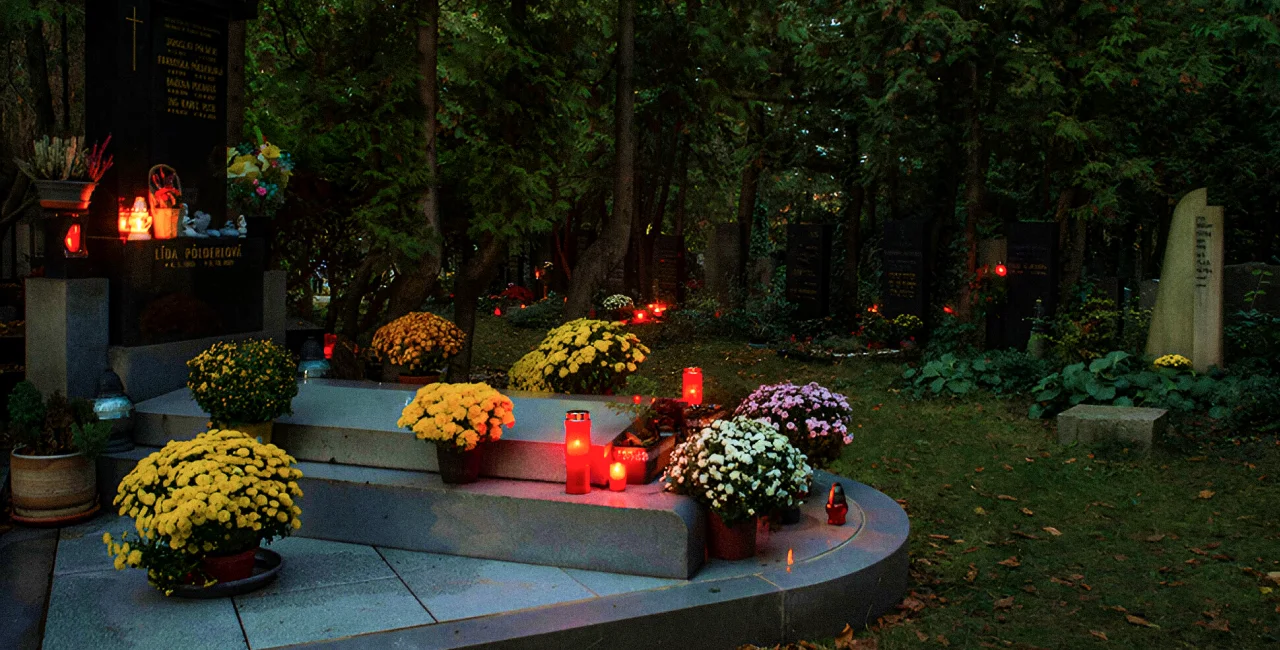As Prague prepares for the quiet, candle-lit glow of Dušičky, or All Souls’ Day, on Nov. 2, the city's cemeteries are gearing up for their busiest day.
This traditional day of remembrance sees people visiting cemeteries to leave flowers, light candles, and honor the memory of loved ones. But there’s more to Prague’s cemetery culture than meets the eye. In a city where cremations and secular funerals are the norm, customs, and perceptions of death may be a revelation to the uninitiated.
To learn more, we spoke with Kateřina Pavlitová from Prague Cemetery and Funeral Services, who offered insights into local practices, cemetery etiquette, and the city’s growing openness to discussing death.
Non-traditional memorials gaining ground
Pavlitová tells us that a sizable portion of Czechs feel uncomfortable with traditional funerals and often specify, either in their wills or through verbal instructions to their families, that they prefer not to have a formal funeral service.
"These people are typically cremated, and their ashes given to the family, who may or may not decide to hold a memorial later on, often a smaller event with few guests that allows the grieving family to mark their passing in some way," she says.
We see an increasing number of outdoor ceremonies and alternative settings, such as our pohřební ateliér [funeral parlor], a venue reminiscent of a home. With our support, families can hold self-created memorials and funeral ceremonies. We see a growing interest in this type of service."

Czechs tend to favor cremation over traditional burials by a considerable margin. In Prague, that percentage is up to 97 percent, more than in most European countries and the U.S. Secular, private memorials, often held in funeral halls unaffiliated with any church, are the norm, though Pavlitová says in Prague, individualized, sometimes non-traditional memorials are gaining ground.
In 2023, Prague Funeral Services opened the country's first natural cemetery providing eco-friendly burial options at the Ďáblice cemetery. This meadow-like area complements the 2015 Memorial Forest, where ashes are interred among trees, further expanding green funeral options to accommodate the growing preference for sustainable and personalized farewells.
Breaking taboos: Gravedigging workshops and community events
As the taboos around death seem to be lifting in Czech society, Pavlitová explains that the funeral industry and all the professions associated with it still tend to be viewed with a degree of squeamishness. "We would like to challenge and, ultimately, change that," she says. To that end, Prague’s Cemetery and Funeral Services recently introduced an unconventional initiative: gravedigging workshops.
Held during its October open days, the event sold out instantly. "The gravedigger profession seems to hold a particular fascination for many people, and there’s even a kind of dark mythology around it...we were delighted with how engaged our workshop attendees were and found the workshop and the entire festival a great platform for communication."
The popularity of these workshops speaks to a gradual shift in attitudes, with people now viewing cemeteries as places of learning and exploration. "We will have more of these, as they are fantastic opportunities for us to educate the public not just about the profession itself but also about how our cemeteries are managed and modern burial practices and trends."
Visiting Prague’s cemeteries: Etiquette and expectations
Prague Cemetery and Funeral Services manages 33, roughly half, of the city’s cemeteries. These include hallowed grounds such as the sprawling Olšany cemetery, the largest burial complex in the country, and the Vyšehrad cemetery, the final resting place of venerated Czech artists, writers, and musicians.
With such historical depth and serene landscapes, the city's cemeteries tend to draw both mourners and admirers. Yet, visitors are often unaware of certain unspoken rules. Visitors to Olšany, for instance, with its ornate tombstones overgrown with ivy, may be tempted to clear the vines from stones. "We strongly discourage this, as the risk of damage to the fragile stone is significant," says Pavlitová.
While many cemeteries double as park-like spaces, they’re foremost areas for reflection and remembrance. Activities like running, biking, or loud conversations or gatherings are unsuitable. Jogging may be allowed if kept discreetly on main paths without disrupting others. Visitors should speak in low tones, to maintain a quiet, respectful atmosphere. Despite these restrictions, people are encouraged to explore and enjoy Prague's municipal cemeteries.
Symbols of remembrance: Time-honored and evolving
The cross is still, even in this largely atheist country, seen as a symbol of death and, by extension, a cemetery. Tombstone motifs include weeping willows, palm fronds, and mourning doves. "One plant, equally beloved and despised, that’s associated with cemeteries is the aforementioned English ivy. It is a beautiful feature of many of our cemeteries, but it needs to be carefully managed," says Pavlitová.
She adds that most death announcements have a traditionally pre-defined format, wording, and a rather somber style that hasn’t significantly changed over the past century. This degree of conservatism may seem somewhat surprising in a society that’s otherwise quite eager to embrace global trends.
"It's important to note that practices surrounding death and funeral rites are quite different between big cities and the countryside, as well as between the more atheist region of Bohemia and more religious (Catholic) Moravia, which still favors traditional rituals and burials."

Dušičky and the rise of cemetery culture
While Halloween seems to have edged into the popular canon this time of year, Pavlitová says it’s not necessarily a competitor to Dušičky.
"Dušičky remains the most important day of the year for any cemetery. People come to clean and decorate the graves of their relatives, light a candle, and take a stroll. It’s a popular time to visit cemeteries, even for those without family buried there, as they look beautiful and festive with all the flowers and lights."
And though kid-friendly Halloween may be here to stay young Czechs are more apt to find meaning in Dušičky. "People in their 20s and 30s seem to be genuinely interested in cemeteries as public spaces that combine nature, art, and history. "We are encouraged by that," says Pavlitová.












 Reading time: 5 minutes
Reading time: 5 minutes 






















